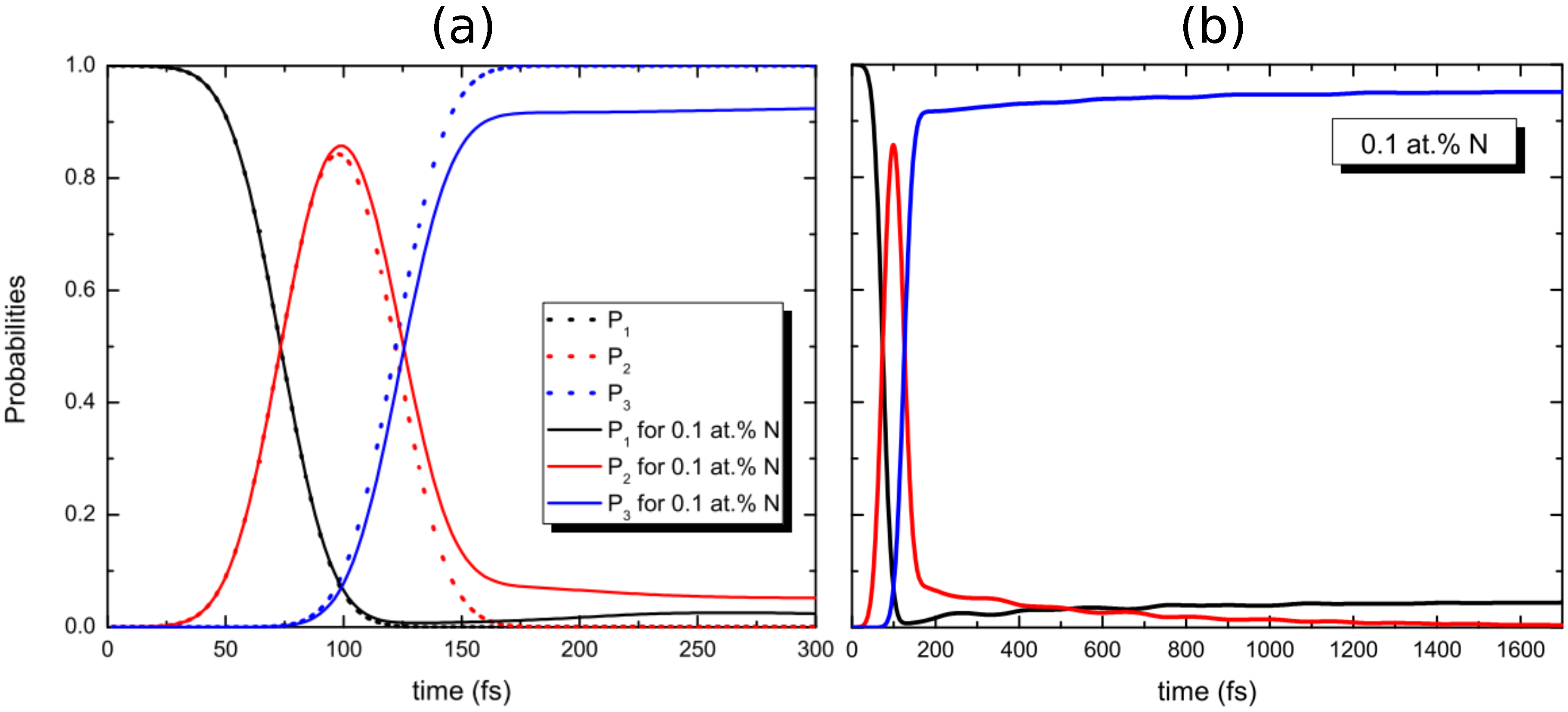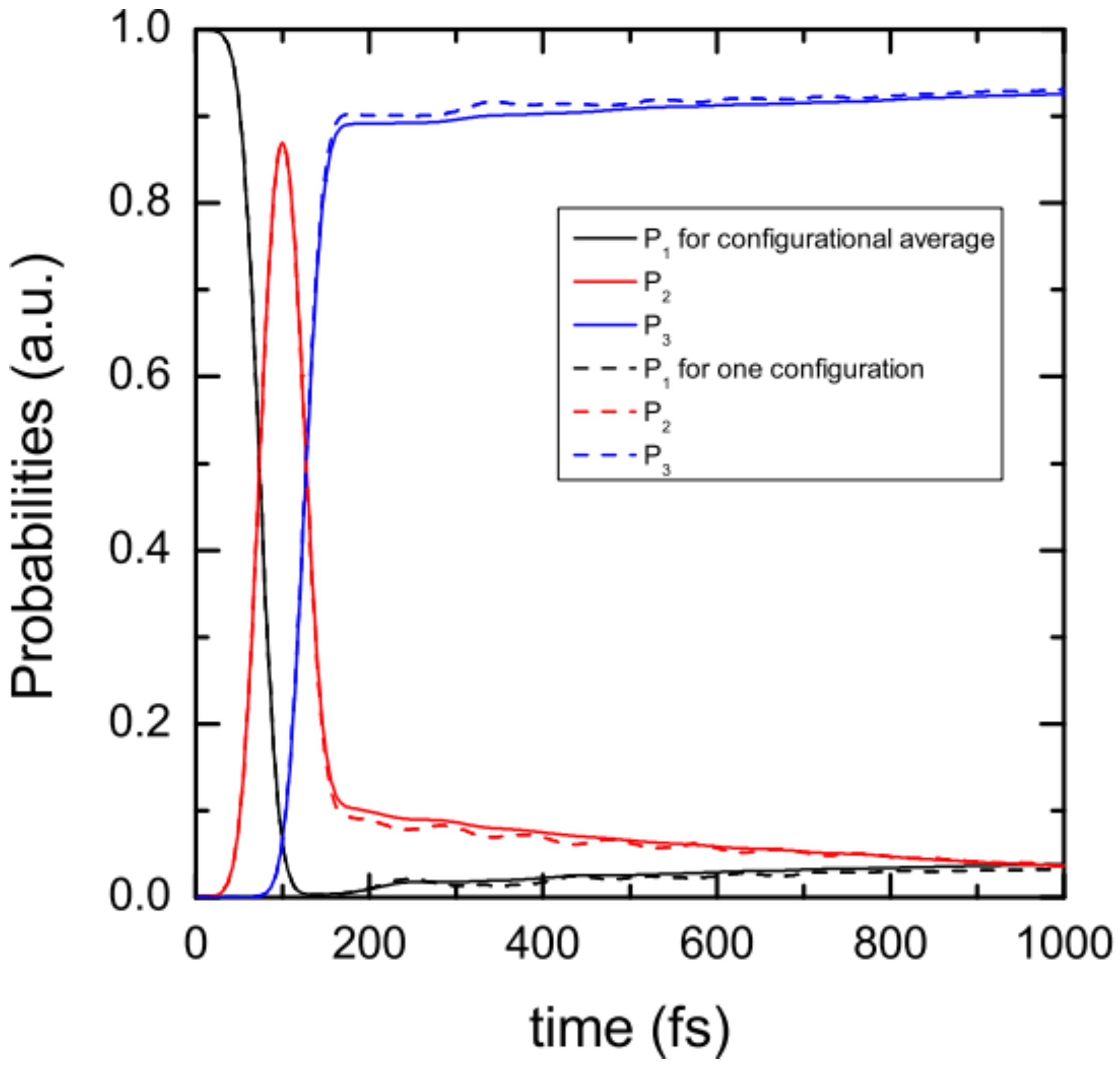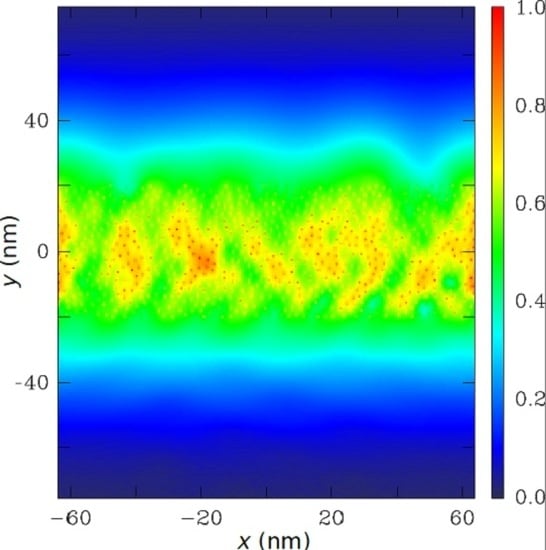Scattering of Dirac Electrons by Randomly Distributed Nitrogen Substitutional Impurities in Graphene
Abstract
:1. Introduction
2. Theoretical Model
3. Results and Discussion
4. Conclusions
Acknowledgments
Author Contributions
Conflicts of Interest
References
- Novoselov, K.S.; Geim, A.K.; Morozov, S.V.; Jiang, D.; Zhang, Y.; Dubonos, S.V.; Grigorieva, I.V.; Firsov, A.A. Electric field effect in atomically thin carbon films. Science 2004, 306, 666–669. [Google Scholar] [CrossRef] [PubMed]
- Novoselov, K.S.; Geim, A.K.; Morozov, S.V.; Jiang, D.; Katsnelson, M.I.; Grigorieva, I.V.; Dubonos, S.V.; Firsov, A.A. Two-dimensional gas of massless Dirac fermions in graphene. Nature 2005, 438, 197–200. [Google Scholar] [CrossRef] [PubMed] [Green Version]
- Zhang, Y.B.; Tan, Y.W.; Stormer, H.L.; Kim, P. Experimental observation of the quantum Hall effect and Berry’s phase in graphene. Nature 2005, 438, 201–204. [Google Scholar] [CrossRef] [PubMed]
- Geim, A.K.; Novoselov, K.S. The rise of graphene. Nat. Mater. 2007, 6, 183–191. [Google Scholar] [CrossRef] [PubMed]
- Novoselov, K.S.; Fal’ko, V.I.; Colombo, L.; Gellert, P.R.; Schwab, M.G.; Kim, K. A roadmap for graphene. Nature 2012, 490, 192–200. [Google Scholar] [CrossRef] [PubMed]
- Liu, H.; Liu, Y.; Zhu, D. Chemical doping of graphene. J. Mater. Chem. 2011, 21, 3335–3345. [Google Scholar] [CrossRef]
- Agnoli, S.; Favaro, M. Doping graphene with boron: A review of synthesis methods, physicochemical characterization, and emerging applications. J. Mater. Chem. A 2016, 4, 5002–5025. [Google Scholar] [CrossRef]
- Wang, H.; Maiyalagan, T.; Wang, X. Review on recent progress in nitrogen-doped graphene: Synthesis, characterization, and its potential applications. ACS Catal. 2012, 2, 781–794. [Google Scholar] [CrossRef]
- Rao, C.N.R.; Gopalakrishnana, K.; Govindaraj, A. Synthesis, properties and applications of graphene doped with boron, nitrogen and other elements. Nano Today 2014, 9, 324–343. [Google Scholar] [CrossRef]
- Willke, P.; Amani, J.A.; Sinterhauf, A.; Thakur, S.; Kotzott, T.; Druga, T.; Weikert, S.; Maiti, K.; Hofsass, H.; Wenderoth, M. Doping of graphene by low-energy ion beam implantation: Structural, electronic, and transport properties. Nano Lett. 2015, 15, 5110–5115. [Google Scholar] [CrossRef] [PubMed]
- Ewels, C.P.; Glerup, M. Nitrogen doping in carbon nanotubes. J. Nanosci. Nanotechnol. 2005, 5, 1345–1363. [Google Scholar] [CrossRef] [PubMed]
- Lu, Y.F.; Lo, S.T.; Lin, J.C.; Zhang, W.; Lu, J.Y.; Liu, F.H.; Tseng, C.M.; Lee, Y.H.; Liang, C.T.; Li, L.J. Nitrogen-doped graphene sheets grown by chemical vapor deposition: Synthesis and influence of nitrogen impurities on carrier transport. ACS Nanao 2013, 7, 6522–6532. [Google Scholar] [CrossRef] [PubMed]
- Xu, W.; Lim, T.S.; Seo, H.K.; Min, S.Y.; Cho, H.; Park, M.H.; Kim, Y.H.; Lee, T.W. N-doped graphene field-effect transistors with enhanced electron mobility and air-stability. Small 2014, 10, 1999–2005. [Google Scholar] [CrossRef] [PubMed]
- Wu, J.; Ma, L.; Yadav, R.M.; Yang, Y.; Zhang, X.; Vajtai, R.; Lou, J.; Ajayan, P.M. Nitrogen-doped graphene with pyridinic dominance as a highly active and stable electrocatalyst for oxygen reduction. ACS Appl. Mater. Interfaces 2015, 7, 14763–14769. [Google Scholar] [CrossRef] [PubMed]
- Terrones, H.; Lv, R.; Terrones, M.; Dresselhaus, M.S. The role of defects and doping in 2D graphene sheets and 1D nanoribbons. Rep. Prog. Phys. 2012, 75, 062501. [Google Scholar] [CrossRef] [PubMed]
- Skrypnyk, Y.V.; Loktev, V.M. Local spectrum rearrangement in impure graphene. Phys. Rev. B 2007, 75, 245401. [Google Scholar] [CrossRef]
- Fujimoto, Y.; Saito, S. Formation, stabilities, and electronic properties of nitrogen defects in graphene. Phys. Rev. B 2011, 84, 245446. [Google Scholar] [CrossRef]
- Brito, W.H.; Kagimura, R.; Miwa, R.H. B and N doping in graphene ruled by grain boundary defects. Phys. Rev. B 2012, 85, 035404. [Google Scholar] [CrossRef]
- Lambin, P.; Amara, H.; Ducastelle, F.; Henrard, L. Long-range interactions between substitutional nitrogen dopants in graphene: Electronic properties calculations. Phys. Rev. B 2012, 86, 045448. [Google Scholar] [CrossRef]
- Lherbier, A.; Botello-Méndez, A.R.; Charlier, J.C. Electronic and transport properties of unbalanced sublattice N-doping in graphene. Nano Lett. 2013, 13, 1446–1450. [Google Scholar] [CrossRef] [PubMed]
- Lawlor, J.A.; Gorman, P.D.; Power, S.R.; Bezerra, C.G.; Ferreira, M.S. Sublattice imbalance of substitutionally doped nitrogen in graphene. Carbon 2014, 77, 645–650. [Google Scholar] [CrossRef]
- Wang, Z.; Qin, S.; Wang, C. Electronic and magnetic properties of single-layer graphene doped by nitrogen atoms. Eur. Phys. J. B 2014, 87, 88. [Google Scholar] [CrossRef]
- Repetsky, S.P.; Tretiak, O.V.; Vyshivanaya, I.G. Electron structure and electric conductivity of graphene with a nitrogen impurity. Ukr. J. Phys. 2015, 60, 170–174. [Google Scholar] [CrossRef]
- Lherbier, A.; Blase, X.; Niquet, Y.M.; Triozon, F.; Roche, S. Charge transport in chemically doped 2D graphene. Phys. Rev. Lett. 2008, 101, 036808. [Google Scholar] [CrossRef] [PubMed]
- Mousavi, H.; Moradian, R. Nitrogen and boron doping effects on the electrical conductivity of graphene and nanotube. Solid State Sci. 2011, 13, 1459–1464. [Google Scholar] [CrossRef]
- Botello-M´ndez, A.R.; Lherbier, A.; Charlier, J.C. Modeling electronic properties and quantum transport in doped and defective graphene. Solid State Commun. 2013, 175–176, 90–100. [Google Scholar]
- Radchenkoa, T.M.; Tatarenkoa, V.A.; Sagalianovb, I.Y.; Prylutskyy, Y.I. Effects of nitrogen-doping configurations with vacancies on conductivity in graphene. Phys. Lett. A 2014, 378, 2270–2274. [Google Scholar] [CrossRef]
- Choi, H.J.; Ihm, J.; Louie, S.G.; Cohen, M.L. Defects, quasibound states, and quantum conductance in metallic carbon nanotubes. Phys. Rev. Lett. 2000, 84, 2917–2920. [Google Scholar] [CrossRef] [PubMed]
- Latil, S.; Roche, S.; Mayou, D.; Charlier, J.C. Mesoscopic transport in chemically doped carbon nanotubes. Phys. Rev. Lett. 2004, 92, 256805. [Google Scholar] [CrossRef] [PubMed]
- Adessi, C.; Roche, S.; Blase, X. Reduced backscattering in potassium-doped nanotubes: Ab initio and semiempirical simulations. Phys. Rev. B 2006, 73, 125414. [Google Scholar] [CrossRef]
- Khalfoun, H.; Lambin, P.; Henrard, L. Long-range resonant effects on electronic transport of nitrogen-doped carbon nanotubes. Phys. Rev. 2014, 89, 045407. [Google Scholar] [CrossRef]
- Khalfoun, H.; Lherbier, A.; Lambin, P.; Henrard, L.; Charlier, J.C. Transport regimes in nitrogen-doped carbon nanotubes: Perfect order, semi-random and random disorder cases. Phys. Rev. B 2015, 91, 035428. [Google Scholar] [CrossRef]
- Biel, B.; Blase, X.; Triozon, F.; Roche, S. Anomalous doping effects on charge transport in graphene nanoribbons. Phys. Rev. Lett. 2009, 102, 096803. [Google Scholar] [CrossRef] [PubMed]
- Padilha, J.; Pontes, R.B.; da Silva, A.J.R.; Fazzio, A. IxV curves of boron and nitrogen doping zigzag graphene nanoribbons. Int. J. Quantum. Chem. 2011, 111, 1379–1386. [Google Scholar] [CrossRef]
- Chauhan, S.S.; Srivastava, P.; Shrivastava, A.K. Electronic and transport properties of boron and nitrogen doped graphene nanoribbons: An ab initio approach. Appl. Nanosci. 2014, 4, 461–467. [Google Scholar] [CrossRef]
- Aktor, T.; Jauho, A.P.; Power, S.R. Electronic transport in graphene nanoribbons with sublattice-asymmetric doping. Phys. Rev. B 2016, 93, 035446. [Google Scholar] [CrossRef]
- Wang, L.; Zhang, Z.; Zhao, J.; Ding, B.; Guo, Y. Nitrogen doping position dependent rectification of spin-polarized current and realization of multifunction in zigzag graphene nanoribbons with asymmetric edge hydrogenation. J. Electron. Mater. 2016, 46, 1165–1174. [Google Scholar] [CrossRef]
- Foa Tores, L.E.F.; Roche, S.; Charlier, J.C. Introduction to Graphene-Based Nanomaterials: From Electronic Structure to Quantum Transport; Cambridge University Press: Cambridge, UK, 2014; pp. 232–298. [Google Scholar]
- DiVincenzo, P.; Mele, E.J. Self-consistent effective-mass theory for intralayer screening. Phys. Rev. B 1984, 29, 1685–1694. [Google Scholar] [CrossRef]
- Castro Neto, A.H.; Guinea, F.; Peres, N.M.R.; Novoselov, K.S.; Geim, A.K. The electronic properties of graphene. Rev. Mod. Phys. 2009, 81, 109–162. [Google Scholar] [CrossRef]
- Maksimova, G.M.; Demikhovskii, V.Y.; Frolova, E.V. Wave packet dynamics in a monolayer graphene. Phys. Rev. B 2008, 78, 235321. [Google Scholar] [CrossRef]
- Rusin, T.M.; Zawadzki, W. Transient zitterbewegung of charge carriers in mono- and bilayer graphene, and carbon nanotubes. Phys. Rev. B 2007, 76, 195439. [Google Scholar] [CrossRef]
- Palpacelli, S.; Mendoza, M.; Herrmann, H.J.; Succi, S. Klein tunneling in the presence of random impurities. Int. J. Mod. Phys. C 2012, 23, 1250080. [Google Scholar] [CrossRef]
- Rakhimov, K.Y.; Chaves, A.; Farias, G.A. Wave packet propagation through randomly distributed scattering centers in graphene. In Low-Dimensional Functional Materials; Egger, R., Matrasulov, D., Rakhimov, K., Eds.; Springer: Berlin, Germany, 2013; pp. 119–126. [Google Scholar]
- Chaves, A.; Covaci, L.; Rakhimov, K.Y.; Farias, G.A.; Peeters, F.M. Wave-packet dynamics and valley filter in strained graphene. Phys. Rev. B 2010, 82, 205430. [Google Scholar] [CrossRef]
- Rakhimov, K.Y.; Chaves, A.; Farias, G.A.; Peeters, F.M. Wavepacket scattering of Dirac and Schrödinger particles on potential and magnetic barriers. J. Phys. 2011, 23, 275801. [Google Scholar] [CrossRef] [PubMed]
- Chaves, A.; Farias, G.A.; Peeters, F.M.; Szafran, B. Wave packet dynamics in semiconductor quantum rings of finite width. Phys. Rev. B 2009, 80, 125331. [Google Scholar] [CrossRef]
- Chaves, A.; Farias, G.A.; Peeters, F.M.; Ferreira, R. The split-operator technique for the study of spinorial wavepacket dynamics. Commun. Comput. Phys. 2015, 17, 850–866. [Google Scholar] [CrossRef]
- Zabet-Khosousi, A.; Zhao, L.; Pálová, L.; Hybertsen, M.S.; Reichman, D.R.; Pasupathy, A.N.; Flynn, G.W. Segregation of sublattice domains in nitrogen-doped graphene. J. Am. Chem. Soc. 2014, 136, 1391–1397. [Google Scholar] [CrossRef] [PubMed]
- Luo, Z.; Lim, S.; Tian, Z.; Shang, J.; Lai, L.; MacDonald, B.; Fu, C.; Shen, Z.; Yu, T.; Lin, J. Pyridinic N doped graphene: Synthesis, electronic structure, and electrocatalytic property. J. Mater. Chem. 2011, 21, 8038–8044. [Google Scholar] [CrossRef]
- Lin, Y.C.; Teng, P.Y.; Yeh, C.H.; Koshino, M.; Chiu, P.W.; Suenaga, K. Structural and chemical dynamics of pyridinic-nitrogen defects in graphene. Nano Lett. 2015, 15, 7408–7413. [Google Scholar] [CrossRef] [PubMed]
- Ando, T. Screening effect and impurity scattering in monolayer graphene. J. Phys. Soc. Jpn. 2006, 75, 074716. [Google Scholar] [CrossRef]
- Nomura, K.; MacDonald, A.H. Quantum transport of massless dirac fermions. Phys. Rev. Lett. 2007, 98, 076602. [Google Scholar] [CrossRef] [PubMed]
- Rusin, T.M.; Zawadzki, W. Zitterbewegung of relativistic electrons in a magnetic field and its simulation by trapped ions. Phys. Rev. D 2010, 82, 125031. [Google Scholar] [CrossRef]
- Degani, M.H.; Leburton, J.P. Single-electron states and conductance in lateral-surface superlattices. Phys. Rev. B 1991, 44, 10901–10904. [Google Scholar] [CrossRef]
- Suzuki, M. Fractal decomposition of exponential operators with applications to many-body theories and Monte Carlo simulations. Phys. Lett. A 1990, 146, 319–323. [Google Scholar] [CrossRef]
- Zhao, L.; He, R.; Rim, K.T.; Schiros, T.; Kim, K.S.; Zhou, H.; Gutiérrez, C.; Chockalingam, S.P.; Arguello, C.J.; Pálová, L.; et al. Visualizing individual nitrogen dopants in monolayer graphene. Science 2011, 333, 999–1003. [Google Scholar] [CrossRef] [PubMed]
- Zheng, B.; Hermet, P.; Henrard, L. Scanning tunneling microscopy simulations of n-doped graphene and single-walled carbon nanotubes. ACS Nano 2010, 4, 4165–4173. [Google Scholar] [CrossRef] [PubMed]
- Joucken, F.; Tison, Y.; Lagoute, J.; Dumont, J.; Cabosart, D.; Zheng, B.; Repain, V.; Chacon, C.; Girard, Y.; Botello-Méndez, A.R.; et al. Localized state and charge transfer in nitrogen-doped graphene. Phys. Rev. B 2012, 85, 161408R. [Google Scholar] [CrossRef]
- Joucken, F.; Tison, Y.; Le Fèvre, P.; Tejeda, A.; Taleb-Ibrahimi, A.; Conrad, E.; Repain, V.; Chacon, C.; Bellec, A.; Girard, Y.; et al. Charge transfer and electronic doping in nitrogen-doped graphene. Sci. Rep. 2015, 5, 14564. [Google Scholar] [CrossRef] [PubMed]
- Khalfoun, H.; Hermet, P.; Henrard, L.; Latil, S. B and N codoping effect on electronic transport in carbon nanotubes. Phys. Rev. B 2010, 81, 193411. [Google Scholar] [CrossRef]
- Landauer, R. Electrical resistance of disordered one-dimensional lattices. Philos. Mag. 1970, 21, 863–867. [Google Scholar] [CrossRef]
- Wang, Z.; Ke, Y.; Liu, D.; Guo, H.; Bevan, K.H. Low bias short channel impurity mobility in graphene from first principles. Appl. Phys. Lett. 2012, 101, 093102. [Google Scholar] [CrossRef]
- Lin, Y.M.; Perebeinos, V.; Chen, Z.; Avouris, P. Conductance quantization in graphene nanoribbons. Phys. Rev. B 2008, 78, 161409R. [Google Scholar] [CrossRef]




| c (at.%) | 0.0 | 0.1 | 0.2 | 0.3 | 0.4 | 0.5 |
|---|---|---|---|---|---|---|
| T | 1.0 | 0.953 | 0.937 | 0.940 | 0.933 | 0.920 |
| (fs) | - | 456 | 590 | 711 | 828 | 1001 |
© 2016 by the authors; licensee MDPI, Basel, Switzerland. This article is an open access article distributed under the terms and conditions of the Creative Commons Attribution (CC-BY) license (http://creativecommons.org/licenses/by/4.0/).
Share and Cite
Rakhimov, K.; Chaves, A.; Lambin, P. Scattering of Dirac Electrons by Randomly Distributed Nitrogen Substitutional Impurities in Graphene. Appl. Sci. 2016, 6, 256. https://doi.org/10.3390/app6090256
Rakhimov K, Chaves A, Lambin P. Scattering of Dirac Electrons by Randomly Distributed Nitrogen Substitutional Impurities in Graphene. Applied Sciences. 2016; 6(9):256. https://doi.org/10.3390/app6090256
Chicago/Turabian StyleRakhimov, Khamdam, Andrey Chaves, and Philippe Lambin. 2016. "Scattering of Dirac Electrons by Randomly Distributed Nitrogen Substitutional Impurities in Graphene" Applied Sciences 6, no. 9: 256. https://doi.org/10.3390/app6090256







